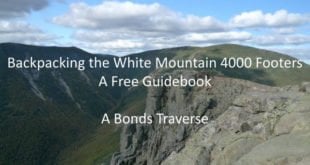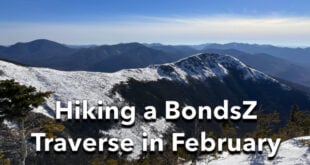The Desolation Loop is a moderately strenuous 41 mile backpack through the eastern half of the White Mountain’s Pemigewasset Wilderness, bounded by the Bonds, Ethan Ridge, Carrigan Notch, and Hancock Notch. There are many excellent swimming holes and wilderness campsites along the route, which will …
Read More »White Mountains
A Mt Isolation Loop Trip Plan: Backpacking the White Mountain 4000 Footers Guidebook
Mt Isolation is a remote 4000 footer located south of Mt Washington with impressive views of the Southern Presidentials and the “rock pile”, as Washington is often referred to locally. This 2-3 day route follows trails seldom hiked by day hikers and …
Read More »A Moriah Loop Trip Plan: Backpacking the White Mountain 4000 Footers Guidebook
The Moriah Loop is a 2-3 day, 24 mile backpacking route that climbs Mount Moriah and its graceful sister peak, Shelburne Moriah, before dropping down to the Wild River. From there, the route loops back through the heart of the Wild River …
Read More »A Bonds Traverse Trip Plan: Backpacking the White Mountain 4000 Footers Guidebook
A Bonds Traverse is a 2 day, 20 mile traverse of Zealand Mountain, West Bond, Mt Bond, and Bondcliff Mountain. Bondcliff is one of the most picturesque mountains on the 4000 footers list and many hikers like to pose for photos on …
Read More »Backpacking a Tunnel Brook Loop Trip Plan: Backpacking the White Mountains 4000 Footers Guidebook
Tunnel Brook is a lush, steep-walled valley on the west side of Mount Moosilauke (4802′). Seldom visited by day hikers, it’s a quiet and secluded place to observe wildlife and witness the avalanche and flash flood damage that Moosilauke and neighboring Mount …
Read More »The Kate Sleeper Loop Trip Plan: Backpacking the White Mountain 4000 Footers Guidebook
The Kate Sleeper Loop is a 2 day, 20 mile backpacking route that climbs four 4000 footers: North and Middle Tripyramid, Whiteface and Passaconaway. The Tripyramids and Whiteface/Passaconaway are usually climbed on separate days by day hikers, but they’re linked together by …
Read More »The Cannonball Loop Trip Plan: Backpacking the White Mountain 4000 Footers Guidebook
The Cannonball Loop is an epic 2 day, 15 mile loop hike that climbs THREE 4000 footers, visits three lakes, and provides outstanding views of Cannon Cliff and Franconia Notch. Don’t let the short distance of this loop hike fool you. It …
Read More »A Carter Wildcat Traverse Trip Plan: Backpacking the White Mountain 4000 Footers Guidebook
A Carter Wildcat Traverse is a 2-3 day, 23 mile traverse of the entire Carter and Wildcat Mountain Ranges, including Mounts Moriah, North Carter, Middle Carter, South Carter, Hight, Carter Dome, and Wildcats A, B, C, D, and E. Hikers are treated to fantastic …
Read More »A Southern Presidential Loop Trip Plan: Backpacking the 4000 Footers Guidebook
A 2-3 day, 22 mile scenic loop that travels up the Dry River Valley, climbing the Oakes Gulf headwall, to a set of alpine lakes at the foot of Mt Washington. From here, hikers climb 4 four thousand footers in sequence: Mt Monroe, …
Read More »Howker Ridge Loop Trip Plan: Backpacking the White Mountain 4000 Footers Guidebook
The Howker Ridge Loop is a 2 day, 18 mile loop that climbs all of the peaks in the Northern Presidential Range: Mounts Madison, Adams, and Jefferson. The route passes several unusual geological features including small peaklets known locally as Howks, an …
Read More »The Rocky Branch Ramble Trip Plan: Backpacking the White Mountain 4000 Footers Guidebook
Mt Isolation is a remote 4000-footer located in the Presidential Range-Dry River Wilderness south of Mt Washington, with outstanding views of Washington, the Southern Presidential Range, the Oakes Gulf Headwall, and the Dry River Valley. Moderate in both length and difficulty, this …
Read More »Hiking Mt Adams and Mt Madison in February
February is the height of winter in New Hampshire’s Presidential Range and it can be difficult to find a weather window where the temperatures and wind speed are safe to climb the higher peaks. I’d passed up a few opportunities the week …
Read More »Hiking a Wildcat Loop
Wildcat ‘A’ and ‘D’ are two 4000 footers on the other side of Rt 16 from Mt Washington and the Presidential Range. Hiking them usually requires an out and back hike, a road walk, or a shuttle. However, there is a way …
Read More »Hiking a Bonds-Z Traverse in February
The Bonds is a group of three adjacent 4000+ foot mountains – Bondcliff, Mt Bond, and West Bond in the middle of the Pemigewasset Wilderness. They’re usually hiked along with Zealand Mountain as a 23-mile traverse when the forest service road leading …
Read More » SectionHiker.com Backpacking Gear Reviews and FAQs
SectionHiker.com Backpacking Gear Reviews and FAQs 












